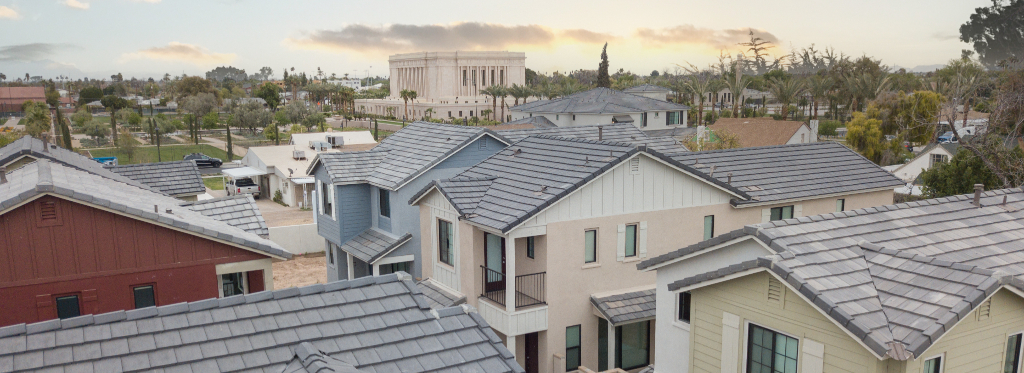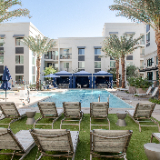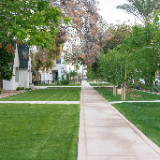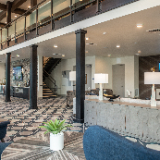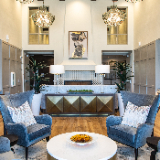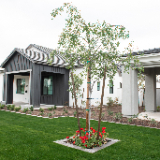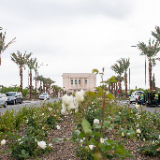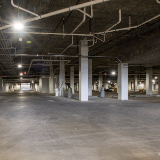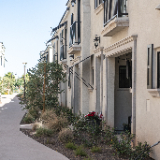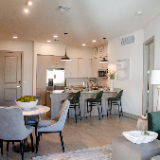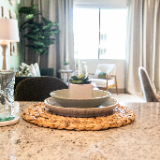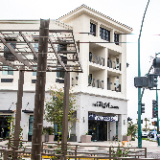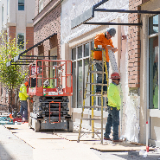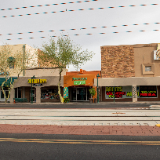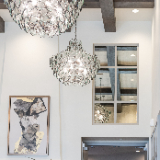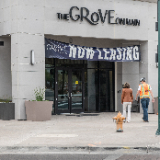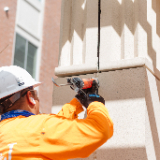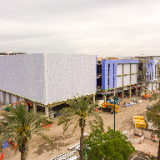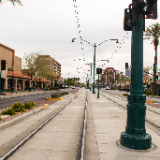The downtown revitalization project for which The Church of Jesus Christ of Latter-day Saints broke ground in 2018 is complete — and locals say it’s helping the city find its soul.
“There was a time where the heartbeat was difficult to find in downtown Mesa,” lamented Mesa Mayor John Giles. The Church, which has maintained a strong presence in Mesa for over a century, redeveloped 4.5 acres of land along the Main Street light rail corridor just west of the Mesa Arizona Temple.
“This was a very challenged area,” Mesa Vice Mayor Jenn Duff said.
“It was an eyesore,” recalled local restaurant manager Omar De La Cruz. “Now it’s looking beautiful.”
A new mixed-use community called The Grove on Main has replaced vacant lots and dilapidated buildings near the temple. The sacred structure, first built in 1927, was recently renovated and will reopen in December 2021.
| Temple Square is always beautiful in the springtime. Gardeners work to prepare the ground for General Conference. 2012 Intellectual Reserve, Inc. All rights reserved. | 1 / 23 |
This story, which is featured in the October 2021 edition of the World Report (a semiannual report of the news of the Church), shows that the driving force of the redevelopment was to protect and enhance the environment around the temple grounds. The Church considers its temples to be the most sacred places on earth. A secondary but essential purpose of the project was to attract businesses and home buyers to infuse more economic life into the community. (The full version of the World Report can be viewed here.)
The Church’s commitment is “huge,” said Mayor Giles, because “some legitimate organization that has resources has got to say, ‘You know what? We see the value in this location. We’re going to maybe take a risk. But we think it’s a great, well-calculated and intelligent risk because we see the potential, and we’re going to take advantage of the public infrastructure that’s in place.’ [The Church’s] decision to invest in our downtown sent a great signal to the rest of the smart investors that said, ‘Well, gee, that if they’re doing it, that’s a sign that it’s got potential [and] can be a reality.’”
The project includes 240 apartments, 12 townhomes, 70,000 square feet of landscaped open space, ground floor retail space and underground parking.
This undertaking, said Bishop W. Christopher Waddell of the Church’s Presiding Bishopric, mirrors a famous line from the movie “Field of Dreams”: If you build it, they will come.
“That’s actually what’s happened here,” Bishop Waddell said. “We’ve built this. The residents have come. In fact, leasing happened at a faster pace than anticipated. Occupancy is at 100 percent.”
“It’s a big, big deal for the community and the region,” said Mike Hutchinson, executive vice president of Phoenix East Valley Partnership, a nonprofit business advocate group. He said The Grove on Main is the linchpin of the current building boom in Mesa. “I’ve talked to a number of developers who looked at this project as this great start [toward] revitalization.”
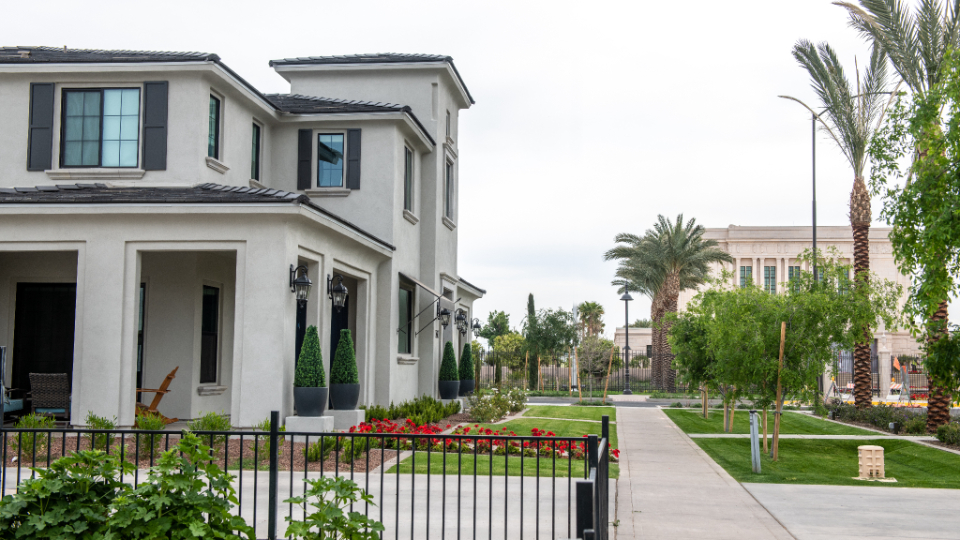
Kary-Ann-Hoopes---03_MesaTEMArea_Updates_Hoopes-5846.jpg
A home on 1st Avenue, a historic district of Mesa, Arizona in May 2021. City Creek Reserve Inc., the real estate arm of The Church of Jesus Christ of Latter-day Saints, restored and remodeled several homes and esthetically improved the street that leads to the front entrance of the Mesa Arizona Temple as part of The Grove on Main, a multi-use construction project. 2021 by Intellectual Reserve, Inc. All rights reserved.Caliber Companies of Scottsdale, Arizona, is one of the businesses investing in several commercial properties in Mesa. John Hartman, the company’s chief investment officer, said they would not have done so without the Church leading out in its commitment to the city.
“[The Church’s example] led people to have the confidence to come down here and say, ‘OK, if a project like this can happen and get leased, then there’s other opportunity,’” Hartman said. He thinks that “downtown [Mesa] in a couple of years is going to be the place to be.”
Vice Mayor Duff confirmed that “we have a lot of shovels in the ground right now. We have about 1,500 units [under construction]. We’re doubling our density in downtown.”
Examples of the development boom include an Arizona State University satellite campus and The GRID, another mixed-use complex that will feature restaurants, retail space and several hundred apartment units.
City Creek Reserve, Inc. (CCRI), the real estate arm of the Church, worked with Scottsdale-based Dale Gordon Design to plan this vibrant, transit-oriented neighborhood. They implemented diverse residential unit sizes, comfortably scaled buildings, Mesa-authentic architecture, and landscaped streets and gardens.
The project’s on-schedule completion was a remarkable feat considering the hurdle of COVID-19. The site never shut down during the pandemic or at any other time, CCRI Vice President Carl Duke said.
“I can’t overstate how challenging it was to build through the pandemic,” Duke said. His team implemented proper health protocols, struggled to attract construction workers, and re-placed orders to procure needed building materials. “We can't deliver a project that’s 99% complete,” he said. “We have to have all of the faucets for every unit. We have to have flooring for every unit.”
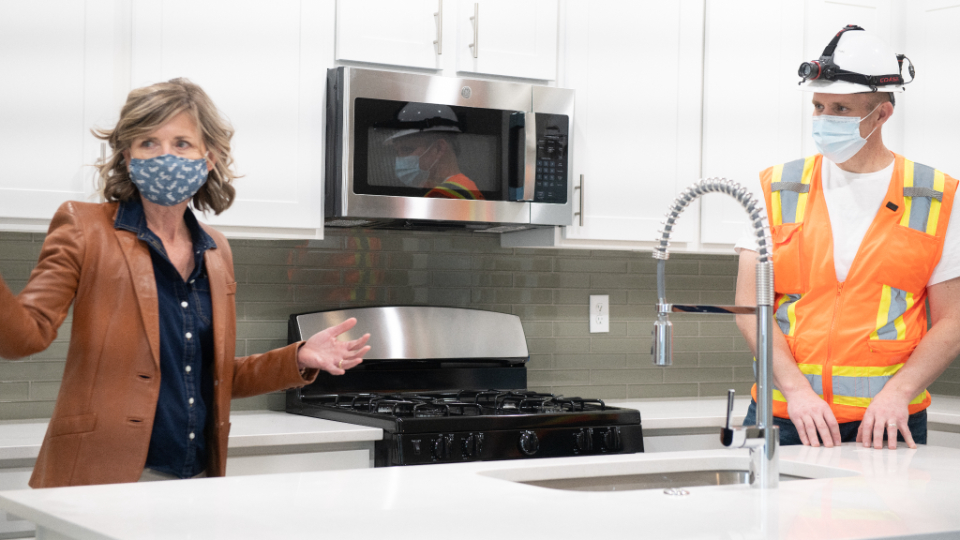
Kary-Ann-Hoopes---03_MesaTEMArea_Updates_Hoopes-5371.jpg
Mesa, Arizona Vice Mayor Jenn Duff discusses upgraded kitchen finishes with City Creek Reserve Inc. Project Manager Carl Duke in one of the spacious condominiums at The Grove on Main, a multi-use construction project by CCRI, the real estate arm of The Church of Jesus Christ of Latter-day Saints in May 2021. 2021 by Intellectual Reserve, Inc. All rights reserved.The new apartments include studio, one-bedroom and two-bedroom floor plans. The townhomes and detached homes feature three-bedroom plans. “The price point is unheard of,” tenant Anna Christensen said. “I thought if I want something like this, I better move on it quick.”
Amenities include a business center and conference room, garden areas, outdoor cooking and firepits, an outdoor games area, a pool, property security, a package concierge and gated parking access. Retail tenants can be accommodated in up to 12,500 square feet of ground-floor space. An underground parking facility (the first such structure in Mesa) has 450 stalls that serve both residential and retail users.
“They’ve really put a lot of thought into every little detail of this place. It’s appreciated. The gas ranges, the nice, brand-new side-by-side refrigerators — somebody actually put thought process into laying out square footage,” Christensen added.
Duke said the architecture has a modern, high-quality look that complements the temple and ties it and the residential area together. The buildings were designed to appear timeless.
“We don’t want this to look old or dated 20 years from now,” Duke said. “So, there’s a great deal of stone, brick [and] tastefully done architectural elements that we hope will stand the test of time, similar to what the temple’s already done up to this day. And that’s hard. It’s hard to build something new and try and look into the future.”
The project also called for several historic homes on First Avenue (the street that leads to the front entrance of the Mesa Arizona Temple) to be remodeled and the street esthetically improved.
“There is still a rich history on First Avenue that is worth preserving,” Duke said. “While it may be more economical to knock down every structure, it was best to preserve the overall feel of the neighborhood. And that’s what we tried to accomplish. [The] street now looks very similar to what it would have looked like in the [1950s] or ’60s.”
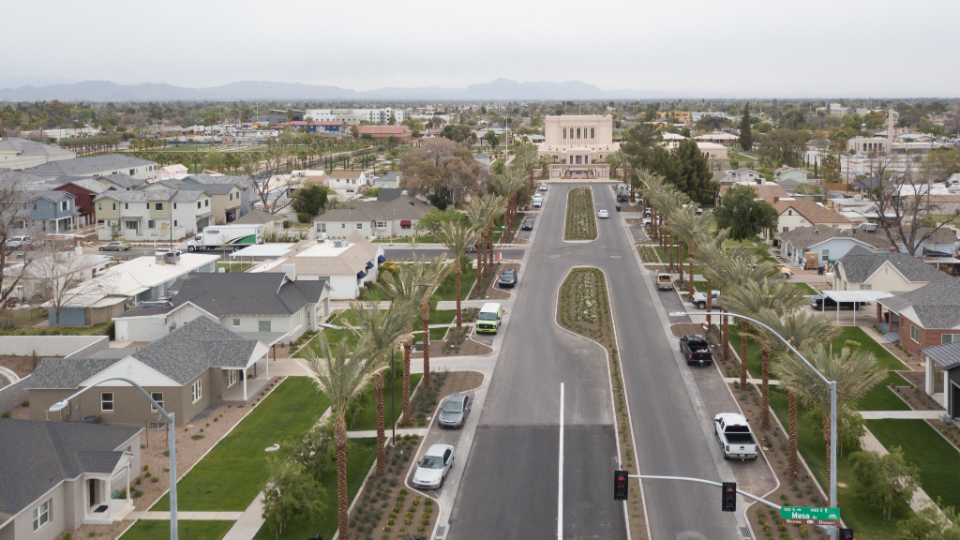
Kary-Ann-Hoopes---03_MesaTEMArea_Updates_Hoopes-0042.jpg
A aerial view from the entrance of 1st Avenue, a historic district of Mesa, Arizona in May 2021. City Creek Reserve Inc., the real estate arm of The Church of Jesus Christ of Latter-day Saints, restored and modeled several homes and esthetically improved the street that leads to the front entrance of the Mesa Arizona Temple as part of a multi-use construction project called The Grove on Main. 2021 by Intellectual Reserve, Inc. All rights reserved.In addition to protecting and enhancing the area around the temple, the Church also contributed time and money to strengthen the city’s infrastructure. The Church added drainage systems, fixed electrical and mechanical problems, repaired several miles of streets and planted trees.
Spanish
“This is a beautiful project,” said Jeff McVay, Mesa’s manager of downtown transformation. “We now have a bar that’s been set that we point everybody else to and … say, ‘You need to go look at what The Grove has done, look at the quality of the development there.’”
“It’s similar to what [Church] President [Russell M.] Nelson said when he was talking about vaccines with COVID-19,” Bishop Waddell said. “He invited people to be a good global citizen, to do our part. Because we have a significant footprint here in Mesa with the members of the Church and the temple, we felt that we needed to do our part. We’re excited to see the other projects that aren’t ours go up. And we’re excited to see what happens to the community. We’re just grateful that we’ve been able to be a part of it.”
